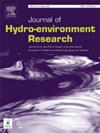人为活动对干旱传播影响评价的概念框架
IF 2.3
3区 环境科学与生态学
Q2 ENGINEERING, CIVIL
引用次数: 0
摘要
这项研究填补了理解人类活动与干旱传播之间复杂关系的一个关键空白,承认了全球对水资源短缺的日益关注。它旨在通过提出评估其影响的概念框架,加强对影响干旱动态的人为驱动因素的理解。提议的框架包括在受干扰和未受干扰期间使用SWAT模型进行水文建模,以及对气象和水文干旱的评估。此外,它还包括利用基于copula的方法评估干旱传播概率的概率分析和对人为活动影响的评估。使用Nash-Sutcliffe效率(NSE)和决定系数(R2)评估SWAT模型的性能,在校准时产生的值为0.84和0.86,在验证时产生的值为0.81和0.80。此外,用于确定流量变化点的Pettitt测试显示了不同时期的未受干扰和受干扰条件。径流干旱指数(SDI)分析显示,未受干扰期轻度干旱占25.77%,中度干旱占9.39%,重度干旱占3.13%。干扰期轻度干旱发生率为41.67%,中度干旱发生率为11.76%,重度干旱发生率为7.35%。此外,干旱传播时间分析表明,在干旱传播期间,人为活动显著影响了水文干旱(HD)和气象干旱(MD)的变化。未受干扰期的气象干旱阈值和严重程度增加了46%,而受干扰期的变化幅度更大,在3% ~ 64%之间。这些发现具有重要的现实意义,强调人类活动加剧了干旱风险并改变了干旱传播的自然模式。总的来说,从这项研究中获得的见解可以支持制定基于证据的政策和适应性管理实践,以加强易受缺水影响地区的抗旱准备和抗旱能力。本文章由计算机程序翻译,如有差异,请以英文原文为准。
A conceptual framework for impact assessment of anthropogenic activities on drought propagation
This research addresses a critical gap in understanding the complex relationship between anthropogenic activities and drought propagation, acknowledging the growing global concern over water scarcity. It aims to enhance the understanding of anthropogenic drivers influencing drought dynamics by proposing a conceptual framework for assessing their impacts. The proposed framework encompasses hydrological modeling using the SWAT model during both disturbed and undisturbed periods, as well as assessments of meteorological and hydrological droughts. Additionally, it includes a probabilistic analysis utilizing a copula-based approach to evaluate drought propagation probabilities and an assessment of the impacts of anthropogenic activities. The performance of the SWAT model, evaluated using Nash-Sutcliffe Efficiency (NSE) and the Coefficient of determination (R2), yielded values of 0.84 and 0.86 during calibration, and 0.81 and 0.80 during validation. Additionally, the Pettitt test, used to identify streamflow change points, indicated distinct periods of undisturbed and disturbed conditions. Analysis of the Streamflow Drought Index (SDI) revealed that 25.77% of the undisturbed period experienced mild drought, 9.39% moderate drought, and 3.13% severe drought. In contrast, the disturbed period saw 41.67% mild drought, 11.76% moderate drought, and 7.35% severe drought. Moreover, the analysis of drought propagation time revealed that anthropogenic activities significantly influenced variations in hydrological drought (HD) and meteorological drought (MD) during the propagation of HD. The undisturbed period displayed a 46% increase in meteorological drought thresholds and severity levels, while the disturbed period exhibited more substantial variations, ranging from 3% to 64%. These findings have significant real-world implications, highlighting that anthropogenic activities intensify drought risks and alter the natural patterns of drought propagation. Overall, the insights gained from this study can support the development of evidence-based policies and adaptive management practices that enhance drought preparedness and resilience in regions vulnerable to water scarcity.
求助全文
通过发布文献求助,成功后即可免费获取论文全文。
去求助
来源期刊

Journal of Hydro-environment Research
ENGINEERING, CIVIL-ENVIRONMENTAL SCIENCES
CiteScore
5.80
自引率
0.00%
发文量
34
审稿时长
98 days
期刊介绍:
The journal aims to provide an international platform for the dissemination of research and engineering applications related to water and hydraulic problems in the Asia-Pacific region. The journal provides a wide distribution at affordable subscription rate, as well as a rapid reviewing and publication time. The journal particularly encourages papers from young researchers.
Papers that require extensive language editing, qualify for editorial assistance with American Journal Experts, a Language Editing Company that Elsevier recommends. Authors submitting to this journal are entitled to a 10% discount.
 求助内容:
求助内容: 应助结果提醒方式:
应助结果提醒方式:


